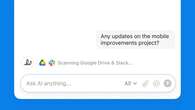The fight against quiet quitting has continued for years, but rates of employee engagement remain stubbornly low.
In 2023, Gallup found that a mere 33% of workers were “engaged in their work and workplace.” That might sound dire, but the peak engagement rate Gallup ever recorded was 36%, back in 2020.
Of course, this overall lack of engagement has a significant cost for businesses. “Trends in employee engagement are significant because they are linked to many performance outcomes in organizations,” writes Gallup’s Jim Harter, Gallup’s chief scientist of workplace management and wellbeing. “Not engaged or actively disengaged employees account for approximately $1.9 trillion in lost productivity nationally.”
At Fast Company’s Innovation Festival last week, several executives discussed what they are doing to support engagement at their own organizations—especially given the challenges posed by the adoption of artificial intelligence in the workplace.
“We’ve got to demystify [AI],” said Ken Moore, chief innovation officer at Mastercard. “Sometimes it can sound scarier than it is, when you’re looking at it as something coming at you, versus something that you can be a part of—and help shape.” He said that Mastercard has meeting-free days and encourages its staff to use that time to learn about AI.
Widespread AI adoption in the workplace understandably causes anxiety for many workers. For instance, a recent Microsoft study found that 53% of individuals who use AI at work have concerns about using it on important tasks, as it might make them seem replaceable. One thing that can help engagement is focusing on how to involve employees in AI-based solutions, says Moore. “We’re a growth company. It’s not really about role elimination for us. It’s about being able to extend the services that we have.”
Hanneke Faber, CEO of electronics company Logitech, agreed. “I am framing it very similarly,” she said. “We said we’re going to [adopt AI] internally to do more with the same people, not to fire a whole bunch of people.” She says they’re seeing AI help employees increase efficiency—and not just for tech workers. “We see the internal productivity definitely in software engineering, but also on the creative side.”
Ultimately it’s on leaders to cultivate the type of environment that encourages employee participation and creativity, amid the latest disruptions in tech, said Bob Stiller, founder of Keurig Green Mountain. “Clearly the leader of the organization [should be accountable],” he said. “It’s their responsibility to make sure everything else is in place.”









No comments